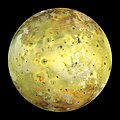Berkas:Io highest resolution true color.jpg

Ukuran pratayang ini: 600 × 600 piksel. Resolusi lainnya: 240 × 240 piksel | 480 × 480 piksel | 768 × 768 piksel | 1.024 × 1.024 piksel | 2.048 × 2.048 piksel | 3.196 × 3.196 piksel.
Ukuran asli (3.196 × 3.196 piksel, ukuran berkas: 1,88 MB, tipe MIME: image/jpeg)
Riwayat berkas
Klik pada tanggal/waktu untuk melihat berkas ini pada saat tersebut.
| Tanggal/Waktu | Miniatur | Dimensi | Pengguna | Komentar | |
|---|---|---|---|---|---|
| terkini | 21 Agustus 2018 06.00 |  | 3.196 × 3.196 (1,88 MB) | The NMI User | Reverted to version as of 23:57, 14 July 2018 (UTC): Needs margins from Kaldari because the crops are too close on all sides in this photo. |
| 20 Agustus 2018 20.08 |  | 2.796 × 2.796 (1,81 MB) | Jdx | Reverted to version as of 18:51, 9 May 2010 (UTC) | |
| 6 Agustus 2018 01.55 |  | 3.196 × 3.196 (1,88 MB) | Jcpag2010 | Reverted to version as of 23:57, 14 July 2018 (UTC) | |
| 2 Agustus 2018 05.40 |  | 2.796 × 2.796 (1,81 MB) | PlanetUser | Reverted to version as of 18:51, 9 May 2010 (UTC) | |
| 14 Juli 2018 23.57 |  | 3.196 × 3.196 (1,88 MB) | Kaldari | margins | |
| 21 Desember 2015 00.42 |  | 2.796 × 2.796 (1,81 MB) | PlanetUser | Reverted to version as of 18:51, 9 May 2010 (UTC) | |
| 23 Oktober 2015 19.09 |  | 2.952 × 2.940 (1,8 MB) | Jacek Halicki | frame | |
| 9 Mei 2010 18.51 |  | 2.796 × 2.796 (1,81 MB) | Julia W | sorry, trying that again | |
| 9 Mei 2010 18.35 |  | 2.796 × 2.796 (5,2 MB) | Julia W | fresh conversion to jpeg from tiff, at higher quality | |
| 23 April 2006 19.39 |  | 2.796 × 2.796 (771 KB) | Uwe W. | Original Caption Released with Image: NASA's Galileo spacecraft acquired its highest resolution images of Jupiter's moon Io on 3 July 1999 during its closest pass to Io since orbit insertion in late 1995. This color mosaic uses the near-infrared, gr |
Penggunaan berkas
15 halaman berikut menggunakan berkas ini:
- Belerang
- Io (satelit)
- Satelit Jupiter
- Pengguna:Agung.karjono/Bak pasir/Timbal(II) nitrat
- Wikipedia:Arsip halaman utama/2021/01/07
- Wikipedia:Arsip halaman utama/2022/01/07
- Wikipedia:Arsip halaman utama/2023/01/07
- Wikipedia:Arsip halaman utama/2024/01/07
- Wikipedia:Gambar pilihan/Usulan/2020
- Wikipedia:Gambar pilihan/Usulan/2020/Periode 5
- Wikipedia:Gambar pilihan/Usulan/2021
- Wikipedia:Gambar pilihan/Usulan/2021/Periode 12
- Templat:Hari Ini Dalam Sejarah/Januari
- Portal:Bintang
- Portal:Bintang/Projects
Penggunaan berkas global
Wiki lain berikut menggunakan berkas ini:
- Penggunaan pada af.wikipedia.org
- Penggunaan pada als.wikipedia.org
- Penggunaan pada an.wikipedia.org
- Penggunaan pada ar.wikipedia.org
- كبريت
- بلوتو
- بوابة:علم الفلك/تصنيفات
- أقمار المشتري
- أقمار غاليليو
- آيو (قمر)
- قالب:المجموعة الشمسية
- قائمة أجرام المجموعة الشمسية مرتبة حسب الحجم
- قائمة أجرام النظام الشمسي المستديرة بالجاذبية
- قائمة الأقمار الطبيعية
- خط زمني لاكتشاف كواكب المجموعة الشمسية وأقمارها
- اكتشاف واستكشاف النظام الشمسي
- قائمة أنواع الكواكب
- بوابة:المجموعة الشمسية/هل تعلم/2
- مستخدم:ASammour/صور مختارة في الفارسية والتركية
- 1981 ميداس
- مرصد براكين آيو
- Penggunaan pada ary.wikipedia.org
- Penggunaan pada arz.wikipedia.org
- Penggunaan pada ast.wikipedia.org
- Penggunaan pada azb.wikipedia.org
- Penggunaan pada az.wikipedia.org
- Penggunaan pada ba.wikipedia.org
- Penggunaan pada be-tarask.wikipedia.org
- Penggunaan pada be.wikipedia.org
- Penggunaan pada bg.wikipedia.org
- Penggunaan pada bh.wikipedia.org
- Penggunaan pada bn.wikipedia.org
Lihat lebih banyak penggunaan global dari berkas ini.





